12 Management of Living Resources
Jason Kelsey
We have explored human use of non-living resources such as water, soil (ignoring that it contains many living components!), and fossil fuels in preceding chapters. Among other important ideas we noted, recall that demand for these coveted materials increases as the number of people and standards of living go up. Our focus now turns to two examples of ways living resources are exploited and managed by humans as well as some important consequences that come from these activities. Keep in mind that environmental scientists seek to protect more than the two specific types described here, but we will explore just forests and fisheries in Chapter 12 because they provide important examples of the kinds of challenges faced in balancing human demands against those of natural systems.
Key concepts
After reading Chapter 12, you should understand the following:
- The many services provided by natural forests
- The causes and consequences of deforestation
- The strategies used to protect forests
- How fisheries are defined and why they are highly valued
- Overfishing and other threats to the health of fisheries
- Steps that can be taken to protect fisheries
- The costs and benefits of aquaculture
- The roles played by governmental agencies in the protection of living resources such as forests and fisheries
Chapter Contents
12.1. Forest Management
12.2. Fisheries Management
The Chapter Essence in Brief
12.1 FOREST MANAGEMENT
12.1.1. What is a forest?
Simply put, forests are ecosystems dominated by trees, although they can vary considerably in the organisms that inhabit them. As we have learned in Chapter 5 and elsewhere, the identity of the species found in an area depends on environmental factors such as temperature, quantity of precipitation, soil properties, and sunlight availability. Successional stage (Chapter 5) plays a critical role as well. Besides the trees, other appropriately adapted organisms (animals, microorganisms, plants) live within forests, employing many strategies and interactions to survive.
12.1.2. Why are forests important?
Forests provide many benefits
Here we look at some of the reasons forests are valued and why so much effort is put into their conservation.
Ecosystem services. This term refers to the many benefits forests provide by their continued existence and normal functioning.
Habitat
As noted above, forests are types of ecosystems in which many organisms live together. Clearly trees play a critical role in the health of these systems and, without them, important animals (birds, mammals, insects and so forth) would struggle to survive. Since humans are interested in protecting those other organisms, they are motivated to maintain forests.
Resistance to erosion
Forest soils stay in place because of the presence of trees and other plants for two important reasons. First, the branches and leaves of the trees form a physical barrier, or canopy (see Chapter 5), that blocks or intercepts precipitation before it strikes soil; consequently, the damage done by direct impacts of raindrops is greatly reduced. Second, the underground networks of roots provide stability and limit topsoil loss in ways we examined during the discussion of land clearing and agriculture (Chapter 9).
Enhancement of water quality and supply
Trees and other plants affect the hydrologic cycle (Chapter 4) in several ways. First, by holding soil in place and intercepting precipitation, forests minimize the amount of sediment damage to nearby waterways (Chapter 9). Second, interception slows the velocity of falling water and allows the soil surface to remain relatively permeable. As a result, infiltration is more likely than is runoff, and local supply of water is therefore enhanced (see Chapter 4 to review these pathways of the hydrologic cycle).
As primary producers, trees convert CO2 into glucose (Chapters 4 and 5). This fixation of carbon is a necessary pathway of the C cycle because it helps recycle carbon atoms and make them available for consumers plus it provides a counterbalance to aerobic respiration and other processes that generate gaseous CO2. Trees are therefore said to store or sequester large amounts of carbon that could otherwise enter the atmosphere (note that big, i.e., old, trees and forests are repositories of a large fraction of terrestrial fixed C, far more than young trees). You should realize that, despite the actions of the planet’s primary producers, the amount of carbon dioxide gas in the atmosphere has been increasing since the end of the 1800s. This lack of equilibrium is largely due to anthropogenic activities such as combustion of wood and fossil fuel, that is, primary production cannot keep pace with the current rate of input. The situation only gets worse as forests are lost. We will see more about the balance between production and fixation of carbon dioxide when we consider global climate change in Chapter 14.
Other benefits. Human quality of life certainly is enhanced by the services described above, although the benefits are derived indirectly. Here we see some direct ways humans use forests.
Recreation
Many forested areas are maintained for activities such as hiking, camping, and picnicking.
Source of raw material
Commercial forestry is a large industry that takes trees from both private and public lands. The wood collected is processed and used as building material and in the production of paper products. Some of the wood burned as a fuel, a practice that extends far back into human history. These days, wood still provides about 6% of our worldwide energy supply (serving as the primary fuel source some 2 billion people[1]). The consequences of logging vary and depend on the techniques used to cut down trees.
Selective cutting. This strategy removes only some of the trees in an area. Since many trees remain standing after harvest, the forest can continue to provide valued services. If done appropriately, a forest of trees of different ages can be developed. Figure 12.1a shows a typical outcome of selective cutting.

Clearcutting. This second approach to harvesting removes all the trees present in an area at one time (Figure 12.1b).
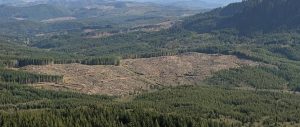
Certainly quicker and more efficient than selective cutting, it also brings immediate and dramatic changes to an existing ecosystem. Many possible outcomes can follow clearcutting, including landslides (see Chapter 7). In some cases, entire forests are deliberately burned instead of being harvested. Among other consequences of these intentional fires: the organic carbon stored in trees is converted to CO2 gas.
12.1.3. Deforestation: causes and consequences
Deforestation leads to losses of services
It should go without saying that humans and natural systems can only continue to benefit from forests as long as forests persist. Losses, broadly known as deforestation, can be caused by many anthropogenic and natural forces.
Anthropogenic. Humans can reduce the amount of forested land on Earth in direct and indirect ways.
Direct
Harvesting of wood for building materials and fuel as well as land clearing (using fire or other methods) to create space for agriculture, housing, transportation, and the like require the intentional removal of the trees and other organisms in a forest. The consequences of direct removal of forests vary and depend on the size and extent of the damage done. For example, clearing of an acre or two within a forest will likely bring about less pronounced effects than will the sudden transformation of a thousand acres from thick forest to barren land. Keep in mind, though, that even seemingly subtle changes, like those associated with the construction of a highway (with the resultant habitat fragmentation) could profoundly impact a threatened or endangered species (Chapter 6).
Indirect
Without intending to remove trees or clear space, humans can still adversely affect forests. Emissions from fossil fuel combustion, for instance, can lead to the formation of acid rain and increased stress on trees (Chapter 14). So, because it is done in the interest of electricity generation, coal burning is classified as an indirect cause of deforestation. Climate change due to the release of carbon dioxide and other air pollutants (Chapter 14) can also reduce the survival of certain tree species (climate changes from natural causes, common before humans industrialized, caused deforestation as well). Diversion of water away from forests for agriculture or other human activities belongs in this category, as does the introduction of invasive species (Chapter 6).
Natural. We learned in Chapter 7 that humans are not the only sources of stress on Earth. Forests, like all systems, must also contend with natural hazards.
Tectonic hazards
Earthquakes and volcanoes can be very destructive, as we saw in Chapter 7.
Water
Both too much and insufficient water can damage forest ecosystems. The effects of drought are likely familiar to you: trees (and all plants) will not survive if precipitation drops below critical levels. Remember, though, that the amount of water available to plants is also a function of soil properties and that those soil properties are affected by land use decisions (review Chapter 9 for more about soil). On the other hand, flooding is problematic because standing water will ultimately kill most trees adapted to grow in unsaturated soils. Climate change and rising sea levels have worsened the effects of flooding in coastal regions, submerging forests under saltwater (Figure 12.2).

Parasites
Microbial and animal parasites have the capacity to kill large numbers of trees and bring about wide-spread deforestation. For example, starting in about 1940, populations of Dutch elm trees in North America were devastated by a fungal pathogen that was accidently introduced from Europe[2], and forests were dramatically affected as a result. Infestations by the insect known as the woolly adelgid similarly affects hemlock trees in the eastern United States (Figure 12.3).

Fire
Very large fires, whether caused by natural forces such as lightning strikes or human actions, can devastate hundreds of thousands of acres of forests. Consequently, forest management for most of the past century or so has featured concerted efforts to prevent all forest fires. Unfortunately, this policy has actually increased the frequency of catastrophic fires. As counterintuitive as it may seem, some small fires are necessary to protect forests. See Box 12.1 for a look at ways fire can both destroy and protect forests.
Box 12.1. We can (and should) fight fire with fire.
Most people view fire as the mortal enemy of forests. Yes, a large, out-of-control fire surely is destructive, but periodic small fires tend to protect forests from infrequent but catastrophic fires. If this sounds illogical to you, you are not alone. In fact, professional forest management has featured aggressive fire suppression for much of the past century for the simple reason that trees are made of wood…and wood burns easily. Policy makers reasonably assumed that the best way to protect forests was to prevent all fires. Alas, as usual, the situation is not nearly so straight forward.
Trees shed all sorts of products onto the floor of their forest, including leaves, branches, and bark. This debris dries and becomes readily combustible, meaning it serves as fuel for any fire that might be initiated by whatever cause. Under natural circumstances (i.e., without humans), fires start regularly—every few years or so—and those flammable materials do not accumulate into particularly large piles. Such small fires burn out quickly because they use up their fuel before they can get big and hot enough to ignite the large, standing trees. Saplings and other small plants are often killed, but the tall, old trees escape with little more than charred trunks. Furthermore, fire can stimulate the release of seeds from certain plants and otherwise enables new growth.
What’s the problem? By working to prevent any fires, big or small, from affecting a forest, well-intentioned forest managers encourage the accumulation of unnaturally large piles of extremely flammable debris. And, unfortunately, something will ignite that fuel sooner or later. Imagine, for example, what could happen if a drought followed a couple of decades (or more) of successful fire suppression. One bolt of lightning could lead to an immense and highly destructive fire (actually, no imagination is necessary, as this scenario plays out with some frequency, including during the summer of 2021). Instead of staying low to the ground, the flames reach up to burn the tree crowns (i.e., the high branches where leaves are concentrated) and wipe out an entire forest.
In the past several years, policy makers and managers have incorporated knowledge about the importance of fire into their maintenance schemes. Controlled burns and natural fires have been used to some extent, but decades worth of accumulated fuel still imperils many forests.
12.1.4. How do we protect forests?
Put simply, we can consult our tools of systems analysis: if reforestation and afforestation, that is, recovery of previously forested area and an increase in the amount of land that is forested, respectively, can compensate for losses due to harvesting and land clearing, then there will be no net loss of forests. Approaches to achieving an acceptable balance vary within and among countries, and both public- and private-sector decision makers exert influence over the disposition of forested land. For example, management of forests in the United States is the responsibility of two federal departments (although many local and state agencies play important and, at times, conflicting, roles).
The National Parks Service (NPS) of the Department of the Interior.
The agenda of the NPS is to manage the 85 million acres designated as National Parks[3]. These areas are maintained as recreational sites (camping, hiking, etc.) but are closed to timber harvesting. Thus, it would be fair to say some measure of both conservation and preservation (Chapter 6) is accomplished in these parks: yes, humans are clearly allowed to enter them, but forests here are not used as sources of wood.
The Forest Service (FS) of the Department of Agriculture
The FS manages 193 million acres of land, including forest and grassland areas[4]. The name of the agency might suggest otherwise, but National Forests are open to logging—timber companies buy rights to harvest trees from these federal lands. National forests are also open for mining as well as recreation. The job of the FS is clearly different than that of the NPS, and, although it attempts to manage the forests sustainably, its mission and methods are controversial among some environmental activists and scientists.
Striving for sustainability
So, what is the verdict: are forests increasing or decreasing in size? As is (too?) often the case for us, the answer is not as definitive as we would like it to be.
More trees does not necessarily equate to more forests. You may hear the oft-quoted statistic that there are more trees today than there were a century ago—it is a common talking point among those who believe deforestation is not a problem (or, who wish to make it appear so). Evidence does support the broad claim of an increase in the total number of trees since about 1900, but we need to be careful to distinguish between forest ecosystems, which feature natural biodiversity, and tree plantations, essentially agroecosystems designed to maximize the growth of one tree species and minimize the growth of everything else (refer to Chapter 9). Tree farms, in other words, may support large numbers of trees but they do not provide the same services as forests. Furthermore, long-term trends are very different than those of the past several decades: recent estimates suggest there are half as many trees on Earth today than there were at the start of human civilization[5].
Earth is experiencing net deforestation. According to United Nations scientists, the rate of deforestation outpaced forest growth between 1990 and 2020, even as the rate of loss of forests has slowed in recent years[6]. Among other important consequences of this change: there has been net movement of carbon from the terrestrial biosphere to the atmosphere. Unsurprisingly, neither forest cover nor rates of deforestation are evenly distributed globally, with just five countries (Russia, Brazil, Canada, the U.S., and China) serving as home for more than half of Earth’s forests and Africa and Asia experiencing the highest and lowest rates, respectively, of deforestation[7].
12.2 FISHERIES MANAGEMENT
12.2.1. What is a fishery?
The definition of these aquatic systems is rather broad. According to the Food and Agriculture Organization of the United Nations (UN FAO), a fishery can be defined by one or more of the following: a region of the ocean, the organisms caught, the type of equipment used, or the people involved in the work[8]. In any case, it should be clear that these systems are managed to provide food and income to people.
12.2.2. Why are fisheries important?
Fisheries provide valuable services
Nutrients. However we define them, fisheries harvest organisms that are overwhelmingly consumed by humans. Fish contribute an average of about 15% of the dietary animal protein consumed by half of the people in the world[9]. As you likely expect, those numbers vary with culture, location, and level of development.
Livelihoods and income. The commercial fishing industry provides employment to approximately 10% of the world’s population[10].
Maintenance of organisms and their ecosystems. Although not the primary objective of fisheries management (which can reasonably be understood as the advancement and wellbeing of humans) the health of ecosystems that support commercially important fish is clearly relevant to the industry. Practices that threaten aquatic habitats, such as land clearing, with its resultant sediment damage, for agriculture (Chapter 9) and forestry (above), dumping of waste (Chapters 11 and 13), climate change and sea-level rise (Chapter 14), and the intentional or inadvertent release of chemical and biological pollutants (Chapter 15) are of great concern to those who make their living from fishing. As we will explore in some detail below, commercial fishing itself also can cause substantial degradation of marine ecosystems and the species which rely on them.
12.2.3. Threats to fisheries
The fundamentals of this story are like those of so many others we have encountered: if the rate of removal of a marine organism from the ocean exceeds the rate of replacement of it to the ocean, there will be a decrease in the size of the population of that organism. Natural processes certainly do play roles, but anthropogenic activities have been largely responsible for declines in both commercially important fisheries and, more broadly, marine ecosystems.
Overfishing
This phenomenon involves the unsustainable use of marine resources. A species (fish, lobster, etc.) is said to be overfished if the rate of reproduction of it cannot keep pace with the rate at which it is caught by humans. Here we briefly consider some of the explanations for this important phenomenon.
Unrealistic views of ocean resources. The vastness of the oceans contributes to the faulty conclusion—widely held historically—that no amount of fishing by humans could appreciably affect the number of marine organisms. The fact that many aquatic organisms are r strategists (Chapter 5) can lead one to assume that reproduction is more than sufficient to keep up with harvests. To cite just two examples, an average adult female Atlantic salmon releases about 7,500 eggs upon spawning (after it spends two years at sea), and the female shortnose sturgeon releases somewhere between 30,000 and 200,000 eggs every three to five years[11]. Despite these seemingly high numbers, both species are endangered. We will see other species that have been brought to the brink of extinction by unsustainable harvesting shortly.
Efficient and indiscriminate technology. The commercial fishing industry is like most enterprises in that it strives to be as cost effective and profitable as possible. Technological advances during the past several decades have enabled the capture of large numbers of marine organisms with, relatively speaking, low energy expenditure, effort, and financial investment. For the most part, commercial fishing does not involve people using fishing poles to catch one fish at a time (recreational and subsistence fishing do rely on these approaches). Unfortunately, increased efficiency comes with adverse consequences. First, as stated above, organisms that are commercially important can be extracted from the oceans at very high rates. Second, organisms that are not of interest can also be captured and killed because many of the commonly used fishing techniques do not discriminate among species. That is, in addition to the target fish (for example, bluefin tuna or flounder) many non-target animals (to name just a few, turtles, dolphins, and whales) can be inadvertently taken. This second group of organisms, collectively referred to as by-catch, is typically hauled aboard fishing vessels and then thrown back into the water (often, dead) because it has little commercial value (Figure 12.4).
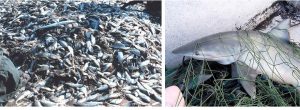
An understanding of the details about equipment used by commercial fisheries is unnecessary to appreciate the problems of overfishing. Keeping things simple, devices that capture target organisms include baited hooks floating at various depths for extended periods of time, purse seine nets that encircle a school of fish (after the fish have been located), trawl nets that are dragged through water or ocean sediment, and box-like devices known as traps that are left and checked periodically (Figure 12.5; see also Box 12.2 for some information about a tool known as a driftnet). The strategy chosen depends on the target species, but all the gear can potentially lead to by-catch. For example, dolphins drown when trapped under water by nets or long lines (remember that they are mammals and breathe air).
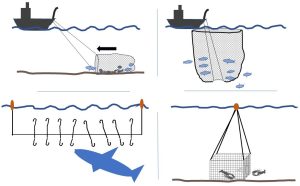
Box 12.2. Driftnets: passive, efficient, deadly
A particularly controversial fishing technique involves the use of driftnets. As the name suggests, these devices are not steered or pulled through the ocean, rather, they are set up in a location (with anchors and floats) and left to passively catch whatever organisms get tangled in them (refer to the diagram, below, a cross-sectional view of a hypothetical net). They are quite efficient at catching fish, but they also lead to a tremendous amount of by-catch. Scientists, policy makers, and activists have concerns about these tools. Among the many potential issues, they are sometimes forgotten or abandoned, meaning they can kill both target and non-target organisms for extended periods. Rules about their use have gotten increasingly strict since the 1980s, although nets as large as 2.5 km in length are still legal in some fisheries[12]. Illegal use continues as well.
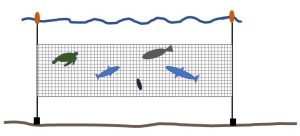
Environmental disruptions
Changes in environmental conditions caused by anthropogenic activities also exert stress on fisheries and can lead to their decline.
Pollution. We have seen that many human activities release physical, biological, and chemical pollutants into natural systems. For example, sediment pollution from agriculture and deforestation can degrade coastal waters and harm fisheries. Ocean dumping of industrial, domestic, and power-generation-related waste introduces many toxic substances as well. Air pollutants from various types of combustion are also of concern because they can mix with precipitation that falls into the oceans. The release of CO2 from fossil fuel combustion is important for multiple reasons, including the way it ultimately leads to acidification of ocean water (we will see more about this and related phenomena immediately below and in Chapter 14). The relationship between environments and organisms is well known to us by now, so it should come as no surprise that a change to the pH of the water in which organisms spend their lives can affect the structure and function of marine ecosystems (see more about pH and acidity in Chapter 9).
Climate change. Since this stressor is addressed in detail in Chapter 14, we will not devote much space to it here. Very briefly, human activities are driving, among other things, increases in the average global temperature, changes in climate on local scales, shifting ocean currents, and rises in sea level. Scientists continue to collect data on the likely consequences of climate change, but it is clear that many economically important marine species have already changed their habits and ranges in response to their altered environments. Monitoring of the distribution of American lobsters in the coastal waters of New England (U.S.A.), for instance, has revealed a distinct shift of population centers further from the shore during the past few decades as these mobile organisms search for cooler waters. Black sea bass, found along the entire eastern coast of the United States, have similarly moved north with time as water temperatures continue to rise[13]. Put into practical terms, owners of commercial vessels need to spend time and money tracking their target organisms and move with them into new locations, often expending more fuel to do so, to maintain their harvests and livelihoods.
Habitat alteration and fragmentation. Changes to habitat overlap with the previous issues about climate change in that they broadly affect the environment of an organism. Humans can alter physical habitats in many ways, for example, through the installation of offshore oil platforms, wind farms, and sea walls. These and similar structures can force organisms to change location and may split a population that was once continuous (more about fragmentation can be found in Chapter 6).
Invasive species. Competition and predation by introduced species can threaten the survival of certain marine species. Review Chapter 6 for more about invasives.
12.2.4. Examples of managed fisheries
The number of protected marine organisms and fisheries is quite high. As usual, space considerations necessitate a limited look at some notable examples. In other words, the few cases described here are intended to provide a sense of the variety of challenges to management and are by no means exhaustive. If you find yourself wanting more, consult the United States NOAA website, fisheries.noaa.gov.
Atlantic salmon
Most people know the fascinating and somewhat unusual salmon story: these are the fish that hatch and spend their early years in freshwater rivers, swim to the ocean for a year or two as adults, and then return to the stream from which they originated to spawn (i.e., mate) and produce the next generation of eggs. They travel great distances, moving back and forth across boundaries among states and countries and, thus, face diverse threats to their survival and success. In addition to natural predation during all phases of their lives, hazards from human activities have hindered them. The several causes of fishery decline described above affect salmon, but some are more important than others. Habitat fragmentation resulting from dam and bridge construction, as well as development of hydroelectricity power generation dams (Chapter 10), impose major impediments to the necessary migration of these fish. Also, excessive harvesting exerted so much pressure on natural salmon populations during the past century that commercial and recreational fishing of wild Atlantic salmon has been banned in the United States since 1948. International cooperation to protect this species from further decline (and the risk of extinction) has increased, yet overfishing in waters outside the jurisdiction of the U.S. government continues to threaten the long-term viability of the fishery[14] (see Box 12.4 for a little more about salmon).
Box 12.4. Wait, what? No Atlantic salmon??
Right: wild Atlantic salmon may not be legally caught in U.S. waters by either commercial or recreational fishers. That fact might surprise you if you have ever bought salmon at an American store or restaurant, where salmon seem to be readily available. So, where do those fish come from? They are raised in fish farms, a topic we will explore later in this chapter.
Sharks
This term refers to hundreds of fish species that, although sharing certain fundamental characteristics, range widely in numerous ways, including size, habitat, prey, and risk posed to humans. In other words, the one-size-fits-all definition used by many people is inadequate and leads to misplaced fears about and attitudes toward these important organisms. It also has fueled the killing of about a hundred million sharks each year (yes, you read that right: 100,000,000).
Modern-day sharks are closely related to organisms that have been in the oceans for hundreds of millions of years. In other words, they both arrived before and outlived dinosaurs. How have they survived for so long? As good environmental scientists we know the short answer: they are extremely well adapted to live in ocean environments. We might say, in a somewhat informal way, they found strategies that worked long ago and have stuck with them. These days, many shark species are struggling against extinction due to pressures from anthropogenic activity that remove them from the ocean faster than they are replaced. Sharks are especially vulnerable to overfishing because they tend to have lower-than-usual reproductive rates relative to other fish. Most of them do not reach sexual maturity for several years and only produce one or two offspring annually. It is difficult to count the numbers of individuals of any ocean species, but data from many different scientific sources indicate that shark populations have declined precipitously during the past several decades. One recently published analysis concludes that the number of known oceanic sharks (and rays, closely related organisms) has decreased by three quarters since 1970[15]. Some species are in better shape than others, however the risk of extinction of these ancient organisms is high overall.
People hunt for sharks for two main reasons: their fins are highly prized for the perceived (but not-supported-by-scientific data) medicinal benefits they provide and, to some extent, for food (e.g., an expensive concoction known as shark fin soup). That second reason has been responsible for the bulk of the loss of sharks from the oceans. It is banned in some countries (including the United States) and highly regulated by international conventions, but shark finning, or the practice of capturing an individual, cutting off its fins, and then throwing the live fish back into the water where it slowly sinks and dies, continues to threaten the survival of sharks worldwide (Figure 12.6). We should also add fear, hate, and misunderstanding to the list of reasons people hunt sharks.
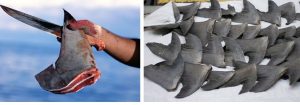
Contrary to popular belief, these animals are hardly our enemies, and you should care about the loss of sharks from the oceans. First, only a very small number of species (among them, great white, bull, white tip, nurse, and tiger) pose a threat to humans, and shark attacks generally occur when a land-based person entering a water-based shark’s habitat is mistaken for prey. Second, sharks play critical roles in their ecosystems because, as top-level predators, they help maintain the size of their prey populations.
American Lobster
This is not a fish, of course, but is an important marine species nonetheless. Lobsters have relatively long life spans (possibly as much as a century, if they escape harvesting), beginning as tiny free-swimming larvae and eventually settling to the seafloor after a few months. They provide a great example of r-selected reproduction: of the many thousands of eggs that can be released by a female at one time, literally just two or three are likely to survive to adulthood[16].
These organisms can be found in the Atlantic Ocean off the northeastern states of the U.S., although the bulk of the population is in the cooler waters near Maine. In recent years, 93% of the commercially harvested American lobsters have come from the Gulf of Maine[17]. This fishery has enormous economic importance: in 2019, for example, it was valued at about $625 million. Many thousands of people depend on lobster for their livelihoods and many millions more expect their demand for lobster as food to be met. Consequently, the ongoing health of these organisms is the focus of much effort and concern.
Management of this fishery is complicated by the fact that it cuts across multiple political boundaries and jurisdictions, and each may have different priorities and agendas. In the U.S., states control the water out to 3 miles from shore whereas NOAA (federal) is responsible for the area between 3 to 200 miles out to sea. A third entity, known as the Atlantic States Marine Fisheries Commission (ASMFC), is a regional organization working to manage many migratory species, including the lobster. It consists of representatives from the fifteen coastal U.S. states that run north-south from Maine to Florida and works cooperatively with individual states, NOAA, and the U.S. Fish and Wildlife Service (FWS)[18]. Together, these groups enact and enforce regulations to protect the fishery. For example, individual lobsters must meet minimum and maximum size requirements (size is a proxy for age) if they are to be kept. Very small lobsters are too immature to have mated and large ones are thrown back because they have the potential to produce very high numbers of eggs (older females produce about 20 times more eggs per breeding event than do younger ones[19]). Other rules aimed to increase sustainability have been enacted as well.
Opinions vary on whether efforts to conserve this fishery will be successful. Harvests in northern waters near Maine have been high for decades and even increased in recent years, leading some people to conclude that the proper balance of input and output has been reached. Others point out that the situation will be difficult to sustain in the long run because harvest rates likely exceed hatching and survival rates for new lobsters. The substantial decline in the fishery in waters south of Maine, for example, near New York and New Jersey, also has raised some concerns. Further complicating matters, climate change exerts substantial pressure on populations (see the note about shifts in lobster population in response to rising water temperature, above), even in the absence of intensive fishing.
Coral reefs
Our final example is different than the others in that it is not a particular organism but is a type of ecosystem that supports multiple species. They are not exactly fisheries, but nevertheless are critical to the health of many marine systems, including those that support the growth of organisms targeted for human harvest. What is a coral reef? They might appear to be built of rocks and similar non-biological materials, but reefs are constructed from the skeletons are living organisms called corals (Figure 12.7).

There are hundreds of different known species of corals, and the ones that form the basis of shallow-water reefs host mutualistic algae inside their tissues[20] (the coral provides habitat and the algae provides fixed carbon—consult Chapter 5 for more about this kind of relationship).
Corals reefs provide many important services. First, they act as a kind of protective barrier between the open ocean and nearby shorelines; reefs dissipate wave energy somewhat, an especially critical function during storms. Second, they are home to a wide variety of marine species adapted to the conditions provided by the reef—these areas are thought to support approximately 25% of the oceans’ biodiversity[21] (Figure 12.8). Third, they are a source of recreation and income for many people. Maintaining healthy reefs is, therefore, of great value on many levels.
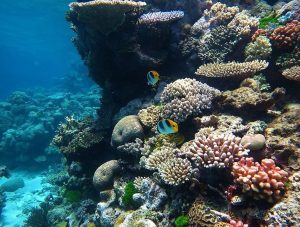
Unfortunately, despite regulations and other types of management, the number of reef-building organisms in the world’s oceans has declined precipitously in recent decades: in U.S. waters alone, the loss is estimated to be between 70 – 80% since the 1970s[22]. Certainly natural stressors such as hurricanes can damage reefs, but several anthropogenic activities play major roles in their decline as well. For example, agriculture has increased the amount of sediment and nutrients flowing to coastal waters (Chapter 9). Trash and other debris dumped into rivers or the ocean (Chapter 13) can similarly affect these sensitive ecosystems. Increases in greenhouse gases in the atmosphere (noted above and Chapter 14) also pose an ongoing threat to reef health. Since coral skeletons are built of calcium carbonate, rising ocean acidity slows coral growth, plus warmer waters damage corals. Finally, the harvesting of fish and the corals themselves can be very destructive, particularly when explosives or cyanide is used (common practices). One important consequence of these and other stressors is a phenomenon known as coral bleaching, that is, the corals become pale as they lose their algal symbionts and approach death[23] (Figure 12.9).
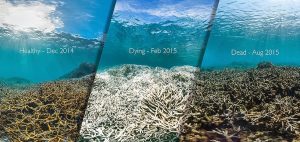
12.2.5. Measures taken to protect fisheries
Protecting fisheries is a high priority for many people, but success requires a combination of science-based laws, enforcement, compliance, cooperation, and innovation.
Laws
Regulating fisheries is complicated for many reasons, not the least of which is the shared nature of ocean resources. Coastal waters are controlled by multiple states and countries having different agendas and priorities, and the open ocean—areas that are outside the jurisdiction of individual countries—is governed by various international agreements. Although we already encountered many of these ideas already, a terse summary of some of the management strategies used to conserve marine organisms is included here.
Several organizations and agencies conserve fisheries. The Food and Agricultural Organization of the United Nations works with member nations to develop and enforce international agreements, and countries (and states, where applicable) have their own regulatory bodies.
Permitting and registration requirements. Those wishing to legally operate a commercial fishing vessel must obtain the appropriate permits to provide accountability and track activity.
Catch limits. Along the coastlines of the United States, NOAA and states set annual limits on how many individuals can be harvested from fisheries. The limits are different for each species and can vary from year to year in response to population assessments. The rules for international waters are different, and some fisheries are not subject to limits.
Gear restrictions. Laws are in place to both limit the catch of a target species and reduce by-catch. In other words, some gear is prohibited in some fisheries (see above for more about common gear used in commercial fishing).
Size restrictions. As noted in the discussion of the American lobster, captured individuals from most fisheries must meet minimum and maximum size requirements if they are to be legally caught. The intention here is to optimize reproduction of a target organism.
Seasonal closings. Some fisheries are only open during a portion of the calendar year to protect species during their spawning seasons. Like so many other rules, these dates vary with organism and from year to year.
Enforcement, compliance, cooperation
The large size of Earth’s oceans makes enforcement of rules, no matter how strict they may be, very difficult and necessarily uneven. It is simply impracticable to keep track of every ship, especially in international waters. Clearly it is in the best interest of fishers to voluntarily adhere to regulations—and most do so—yet illegal fishing (in violation of one or more laws regarding size, season, or gear, for example) does occur. Authorities may board and inspect ships when they are encountered at sea or when returning to port. If evidence of banned practices is found, say, quantities of shark fins without shark bodies, lobsters that exceed the size limit, or individuals of species that are protected from harvesting, impoundments and arrests are possible. Self-reporting and policing by those working in the industry also are important pieces of the compliance puzzle.
Alternatives to commercial marine fisheries
The intense pressure on organisms living in the oceans has spurred people to explore other ways to meet human demand for fish.
Inland freshwater fisheries. The fish in rivers and lakes are taken and used as food, but they are simply not abundant enough to meet more than a small fraction of worldwide demand. They are still regulated by local, state, and national agencies, though. In the U.S., the Fish and Wildlife service is responsible for freshwater fisheries.
Aquaculture. Fish can be intentionally bred and raised in various types of controlled environments in ways that are analogous to those used to grow cattle, chickens, and other animals (Chapter 9). Tree plantations (earlier in this chapter) are comparable as well.
Several strategies are used
Approaches to aquaculture range from the raising of fish in ponds or tanks that are separate from natural marine systems to cages submerged in ocean waters. In many cases, young are bred in hatcheries before they are introduced into wild fisheries or a fish farm enclosure (see Figure 12.10).
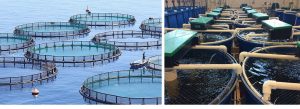
Many types of organisms are farmed
Finfish (e.g., salmon), shellfish (e.g., oysters), and seaweed are all grown in aquaculture systems.
Food production via aquaculture is increasing worldwide
As the human population grows, the need for food, including fish, also goes up. In recent years, aquaculture has met an increasing proportion of that demand: worldwide, about half of all seafood consumed comes from fish farms (although, in the U.S., wild-caught fisheries still dominate)[24].
There are pros and cons of aquaculture
Like land-based agriculture, fish farming offers benefits and brings about adverse consequences. On the plus side it provides food for people and helps protect natural fisheries. Its costs, on the other hand, are not trivial. First, raising fish is very resource intensive. Although research to improve efficiency is ongoing, a lot of pressure is put on natural ecosystems, both marine and terrestrial, to obtain food for farmed organisms. Second, the high density of fish in an enclosure leads to the release of large quantities of nutrients (in the form of fish excrement) and an increase in eutrophication and other types of water pollution. Finally, submerged cages do not provide a fool-proof barrier against movement of fish into the open ocean; farmed individuals that escape can introduce harmful diseases and genetic traits into wild populations.
12.2.6. Oceans are not just sources of human food
The focus of this chapter is the management of natural resources for the purposes of meeting human demands for food and other materials. Before we move on, though, a few words about other reasons to protect marine ecosystems are in order.
Earth is sometimes called “The Blue Planet” for a very good reason: around two thirds of its surface is covered with water. As we learned in Chapter 4, the oceans hold about 97% of that water, and they make up about 99% of the planet’s habitable space[25]. Evidence that life began under water is strong (Chapter 6), although, as most of us reading this book can attest, it has since moved onto land as well. Organisms living in the oceans are critical to the maintenance of natural systems as we know them, including photosynthetic phytoplankton that provide approximately half of Earth’s oxygen[26]. Phytoplankton are also vital because they occupy the first trophic level of marine food webs (including those that support commercially important organisms).
Much research has been conducted on, and much written about, the status of the world’s oceans. Conclusions and predictions vary to some extent, but most people working in the field warn that marine systems are in decline. United Nations scientists, for instance, note several concerns[27], including the following three. First, about 60% of marine ecosystems of direct importance to humans are not being used sustainably, and as many as 13% of commercial fisheries may have collapsed (i.e., are no longer able to support relevant harvesting). Without substantive changes, half of the species in the oceans could face extinction by the year 2100. Second, releases of nutrient pollution, including sewage, ocean dumping, and agriculture have led to hundreds of low-oxygen areas, known as dead zones, in which aerobic organisms (like fish) cannot survive. One of the largest of these zones is found downstream of the Mississippi River (United States) in the Gulf of Mexico. It varies in size but in 2022 covered an area of about 8500 square km[28]. Third, the conditions of mangrove swamps and salt marches, vital coastal ecosystems because they protect the mainland, are breeding areas for many organisms, and are vital carbon sinks (i.e., store carbon that could otherwise move to the atmosphere—more in Chapter 14), have deteriorated precipitously due to chemical pollution and human activities such as boating[29]. Unless steps are taken to protect these and other threatened marine systems, all of Earth’s aquatic and terrestrial biosphere could undergo dramatic changes.
THE CHAPTER ESSENCE IN BRIEF [30]
Ever-increasing demand for food, materials, space, and livelihoods threatens the long-term supply of many coveted resources. Forest and fisheries management serve as two important examples of strategies that can be employed to mitigate declining availability of valued natural products; like all such efforts, they have promise but face multiple challenges.
Think about it some more…[31]
How are clearcutting and conventional farming (Chapter 9) related and how does each contribute to mass wasting (Chapter 7)?
Can resource management counteract extinction (Chapter 6)?
How does deforestation affect the carbon cycle? Spoiler: you will get a similar question after Chapter 14!
How might deforestation harm the livelihood of the captain of a fishing boat? Might this be another episode of the principle of environmental unity???
How can the establishment of a minimum size requirement for a fishery (i.e., a size below which an individual fish is deemed too small to keep) be understood using input-output analysis and a systems model?
So what if we clear the oceans of aggressive sharks? Isn’t that good riddance? Who needs ‘em?
I don’t eat fish, nobody I know earns a living through a fishery, and I live far from a coastline: so, why should I care about oceans?
Why is the protection of fisheries so difficult?
CHAPTER APPENDIX
Alphabet soup: a guide to some relevant agencies
Resource management is carried out by many agencies/groups at the local, state, national, and international level. For your convenience, those most relevant to the topics in this chapter are very briefly described below. Among other things you should note as you look through this list is its disparate nature: the science and business of conservation cuts across many different agencies and jurisdictions.
United States federal agencies
Department of Agriculture (USDA).
This Cabinet-level department is responsible for the very general task of managing food, nutrition, agriculture, and natural resources. The USDA also works to provide economic opportunity for rural areas in America[32].
National Forest Service (NFS). The NFS is part of the USDA and is responsible for the management of forest and grasslands[33]. See the section on forests and forest management, above, for more.
Department of the Interior (DOI).
The secretary of the DOI also is part of the President’s Cabinet. Its mission, as described in its official documents, is to “manage America’s vast natural and cultural resources[34].” Eleven different bureaus fall under the DOI, including the three listed here.
Geological Survey (USGS). The USGS is responsible for the monitoring of natural hazards (e.g., earthquakes), management of water and other essential resources, and the study of ecosystems and the effects of climate change on human and natural systems[35].
Fish and Wildlife Service (FWS). This bureau works to conserve endangered and threatened species (mostly domestically, but contributes to international efforts as well), monitors migratory fish and freshwater fisheries, oversees wetland habitats, and enforces wildlife laws[36].
National Parks Service (NPS). The NPS primarily works to protect natural forests and other areas as described in the section on forests and forest management, above[37].
Department of Commerce (DOC)
You might be surprised to see this department on our list, another whose Secretary is a member of the President’s cabinet. Despite its mission to “create economic growth and opportunity[38] ”, it oversees a bureau that comes up frequently here and in other chapters of this textbook.
National Oceanographic and Atmospheric Administration (NOAA). Its website states “NOAA is an agency that enriches life through science. Our reach goes from the surface of the sun to the depths of the ocean floor as we work to keep the public informed of the changing environment around them[39].” Among NOAA’s responsibilities are management of marine fisheries and coastlines, weather forecasting, and climate monitoring. Its work is done in the context of expanding economic development and opportunities.
International organizations
United Nations Food and Agricultural Organization (UNFAO).
This group is part of the United Nations, meaning it is made up of 193 member states (as of July, 2021). Its mission is to promote food security for all people[40].
State and regional organizations
Atlantic States Marine Fisheries Commission (ASMFC). As noted in the section on fisheries management, above, the ASMFC is a group made up of representatives from several U.S. states, NOAA, and FWS to manage many fisheries along the east coast of the United States[41].
Note also that U.S. states and other countries have offices of environmental protection, fisheries, natural resources, and so forth, although names differ (e.g., Department of Fisheries, Department of Inland Fish and Wildlife, etc.)
- Food and Agricultural Organization of the United Nations. 2021. Wood energy ↵
- Marcotrigiano, Michael. 2017. Elms and Dutch elm disease: a quick overview. In: Pinchot, Cornelia C.; Knight, Kathleen S.; Haugen, Linda M.; Flower, Charles E.; Slavicek, James M., eds. Proceedings of the American elm restoration workshop 2016; 2016 October 25–27; Lewis Center, OH. Gen. Tech. Rep. NRS-P-174. Newtown Square, PA: U.S. Department of Agriculture, Forest Service, Northern Research Station: 2–5 ↵
- US National Parks Service. NPS.gov; the total land area of the United States is around 2.3 billion acres. ↵
- The Forest Service, US Department of Agriculture. fs.usda.gov ↵
- Crowther, T., Glick, H., Covey, K. et al. 2015. Mapping tree density at a global scale. Nature 525:201–205. doi.org/10.1038/nature14967 ↵
- FAO and UNEP. 2020. The State of the World’s Forests 2020. Forests, biodiversity and people. Rome. doi.org/10.4060/ca8642en https://doi.org/10.4060/ca8642en ↵
- FAO and UNEP. 2020. The State of the World’s Forests 2020. Forests, biodiversity and people. Rome. doi.org/10.4060/ca8642en https://doi.org/10.4060/ca8642en ↵
- Fisheries and Aquaculture Department (FAO). 2014. United Nations. fao.org ↵
- Fisheries and Aquaculture Department (FAO, 2021). United Nations. fao.org./rural-employment/agricultural-sub-sectors/fisheries-and-aquaculture/en/ ↵
- Fisheries and Aquaculture Department (FAO, 2021). United Nations. fao.org./rural-employment/agricultural-sub-sectors/fisheries-and-aquaculture/en/ ↵
- National Oceanic and Atmospheric Administration, U.S. Department of Commerce. fisheries.noaa.gov/species ↵
- United Nations. 1998. FAO Fisheries Department. Report of the Food and Agriculture Organization concerning United Nations General Assembly Resolution 52/29 entitled “Large-scale pelagic drift-net fishing; unauthorized fishing in zones of national jurisdiction and on the high seas; fisheries by-catch and discards; and other developments ↵
- NOAA. 2021. “The northeast shelf: a changing ecosystem.” fisheries.noaa.gov ↵
- National Oceanic and Atmospheric Administration, U.S. Department of Commerce. fisheries.noaa.gov/species ↵
- Pacoureau, N., Rigby, C.L., Kyne, P.M. et al. 2021. Half a century of global decline in oceanic sharks and rays. Nature 589, 567–571 ↵
- Fishwatch, fishwatch.gov. Part of the National Oceanographic and Atmospheric Administration. NOAA.gov ↵
- NOAA Fisheries. fisheries.noaa.gov National Oceanographic and Atmospheric Administration. NOAA.gov ↵
- Atlantic States Marine Fisheries Commission. asmfc.org ↵
- Fishwatch, fishwatch.gov. Part of the National Oceanographic and Atmospheric Administration. NOAA.gov ↵
- USGS. Coral reefs. Coastal and marine hazards and resources program. usgs.gov ↵
- USGS. Coral reefs. Coastal and marine hazards and resources program. usgs.gov ↵
- USGS. Coral reefs. Coastal and marine hazards and resources program. usgs.gov ↵
- National Ocean Service. oceanservice.noaa.gov Part of National Oceanographic and Atmospheric Administration. NOAA.gov ↵
- Growth in aquaculture contributes to rise in fish consumption. United Nations. news.un.org ↵
- Living Ocean. Science.NASA.gov ↵
- Living Ocean. Science.NASA.gov ↵
- United Nations educational, scientific, and cultural organization. 2017. unesco.org/ ↵
- What is a dead zone? National Oceanographic and Atmospheric Administration. NOAA.gov ↵
- Human activities such as dredging and careless boating are threatening South Florida’s mangroves and seagrass floridakeys.noaa.gov ↵
- As you will find throughout this book, here is very succinct summary of the major themes and conclusions of Chapter 12 distilled down to a few sentences and fit to be printed on a t-shirt or posted to social media. ↵
- These questions should not be viewed as an exhaustive review of this chapter; rather, they are intended to provide a starting point for you to contemplate and synthesize some important ideas you have learned so far. ↵
- About the US Department of Agriculture. usda.gov/our-agency/about-usda ↵
- This is Who We Are. The Forest Service, US Department of Agriculture. fs.usda.gov ↵
- About Interior. doi.gov ↵
- Who We Are. usgs.gov ↵
- Abpout us. fws.gov/help/about_us.html ↵
- About Us. US National Parks Service. NPS.gov ↵
- About Commerce. commerce.gov ↵
- About Our Agency. NOAA.gov/about-our-agency ↵
- About FAO. fao.org/ ↵
- About Us. Atlantic States Marine Fisheries Commission. asmfc.org ↵
In ecology, the sequential replacement of dominant species in an area; it is mechanism by which an ecological community comes into being. See Chapter 5 for details.
In ecology, a reproductive strategy that involves the release of high numbers of offspring but little or no parental care. See Chapter 5, especially Box 5.2 for more.
A process whereby a relatively clear aquatic system is transformed to first a murky then swampy then, potentially, a dry terrestrial system. It is caused by the accumulation of excess nutrients (nitrogen and/or phosphorus). See Chapters 4 and 11 for details.
